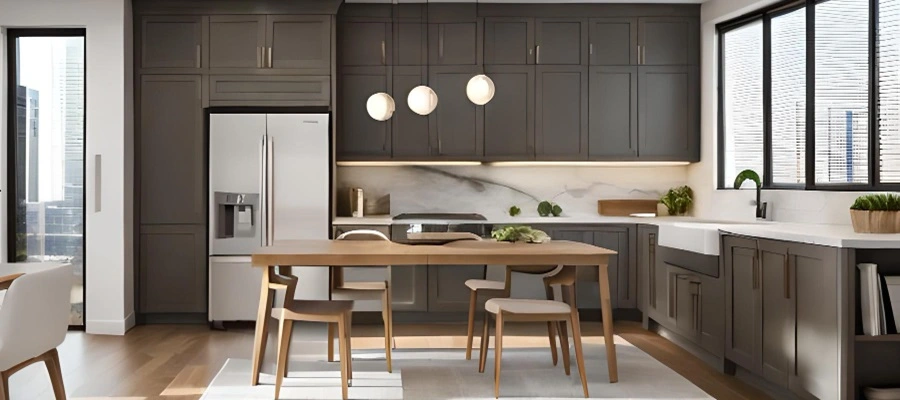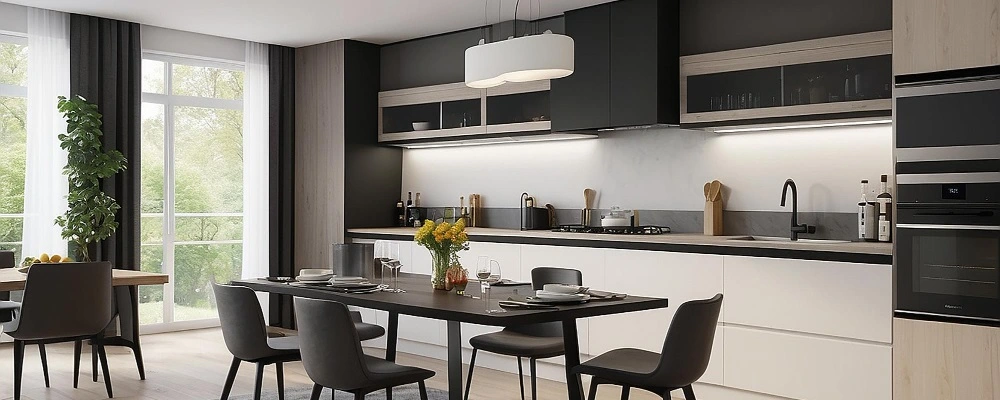A kitchen is a designated area in a home used only for cooking. A kitchen’s primary purposes are to prepare and cook meals, as well as store food and other related items. It is utilized all day, from breakfast in the morning until supper at night. A kitchen is built into every residential building, but these days, it may also be seen in many businesses and places.
The kitchen is normally furnished with a stove, cutlery, sink, refrigerator, microwave, dishwasher, hot and cold water facilities, and other appliances. The kitchen makes it easy for all of the appliances to fit within. So, in this blog, Brick & Bolt explains all the basic information about kitchen layouts and the types of kitchen layouts.
What is the Kitchen Layout?
Arrangments of the countertop, major kitchen appliances, and storage options make a shape called kitchen layout. This floor plan helps define the kitchen’s work triangle. The kitchen work triangle is the route you take while preparing your meal, from the refrigerator to the sink to the stove. When designing a new kitchen and selecting the most ideal cabinetry solutions for your house, kitchen layout is the most important thing to consider.
When selecting a kitchen layout, consider how you and your family will use the area. Most kitchen layouts fall into five basic categories: Straight line, G, L, U, and galley kitchen. You can improve your kitchen layout with the correct cabinets, designing the partition and decorative elements. Depending on the size of your kitchen, you can add a kitchen island to your kitchen layout to increase storage and surface space. The width of the passageways between cabinets and the island is critical. Kitchen islands may come in a variety of shapes and sizes, and they are not restricted to the typical square or rectangular design.
Popular Types of Kitchen Layouts for Modern Homes

The following are the most popular types of kitchen layouts:
- Straight Line Kitchen Or One Line Kitchen
- G Shaped Kitchen Layout
- L Shaped Kitchen Layout
- U Shaped Kitchen Layout
- Galley Kitchen Layout or Parallel Kitchen Layout
Let’s dive deep into all the kitchen layouts-
1. Straight Line Kitchen Or One Line Kitchen
The single-wall kitchen layout is ideal for a small house with limited cooking space. A straight-line kitchen layout has just one platform. A sink is placed between the stove and the refrigerator in a single-wall kitchen setup. When the platform is big enough, it may also hold one or two appliances, such as a mixer, grinder, microwave, etc. A single-wall kitchen layout is often simple and saves space without losing functionality. Cupboards may be installed under the platform to hold kitchen accessories and equipment.
2. G Shaped Kitchen Layout
The G-shaped kitchen layout is a variation of the U-shaped kitchen. It’s ideal for individuals who wish to maximize their kitchen space. The G-shaped kitchen setup expands the storage choices that surround the cooking area on three sides. This layout makes the area seem larger by opening the wall to the next room and creating a pass-through or breakfast nook for the family.
The G-shaped kitchen allows for more storage space for kitchen equipment such as under-counter fridges and freezers, as well as a dishwasher. The G-shaped kitchen plan might look cluttered at times because of the large number of storage units that hang on the walls.
3. L-Shaped Kitchen Layout
If you want to design a functional kitchen, the L-shaped layout is the best option for you. An L-shaped kitchen layout is suitable for areas where the space between two walls is long enough to accommodate all of the essential workstations. This kitchen concept requires a free corner to create the full structure. The corner will serve as a pivot from which both sides of the kitchen countertop will extend perpendicularly to one other. One section of the countertop may be utilized for the sink, preparations, and storage, while the other is ideal for cooking. To achieve ideal balance and symmetry, ensure that both counters are identical in length and dimension.
To give depth to your L-shaped kitchen layout, install a streamlined kitchen chimney with a backsplash below. Do not extend the wall-mounted kitchen cabinets to their full length. Instead, flip the corner and extend the cabinets halfway down the length of the kitchen countertop. This will provide a balanced appearance to the whole region. .
4. U-Shaped Kitchen Layout
In the U-shaped kitchen layout, the kitchen will be shaped like the letter ‘U’. In this layout, two long parallel kitchen countertops will run along both sides of the wall, with a connecting area. This connecting space must be perpendicular to the parallel countertops. You should design the kitchen with adequate space between the two counters to allow for easy mobility. A U-shaped kitchen layout is ideal for big houses. It might make it easier to reach visitors and family members while you’re cooking food.
5. Galley Kitchen Layout or Parallel Kitchen Layout
A galley kitchen layout comprises many parallel platforms and cabinets. This type of kitchen layout is known as a parallel kitchen layout, a galley kitchen layout, or a corridor kitchen layout. A corridor kitchen layout is ideal when doors are required at both ends of the kitchen, and there is plenty of room. If space is not a problem, the galley kitchen may be a highly useful and productive design. Most home cooks choose a corridor or galley kitchen design, which complements the kitchen work triangle. Galley kitchens have many workstations. It gives space for more than one person to work.
Conclusion
On a final note, designing a kitchen involves lots of thought and attention to detail. So, it’s recommended that you understand your needs and then design the kitchen using the available kitchen space, your budget, and the style you choose. A modular kitchen, for example, is often designed in the form of an L or U. A modern kitchen. No matter whatever kitchen style you select, be sure to create a strategic plan that includes all specifics concerning space use, storage, cabinet and shelf designs and placements, appliances, and more.

